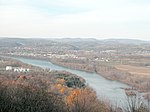Joseph Priestley House

The Joseph Priestley House was the American home of eighteenth-century British theologian, Dissenting clergyman, natural philosopher (and co-discoverer of oxygen), educator, and political theorist Joseph Priestley (1733–1804) from 1798 until his death. Located in Northumberland, Pennsylvania, the house, which was designed by Priestley's wife Mary, is Georgian with Federalist accents. The Pennsylvania Historical and Museum Commission (PHMC) operated it as a museum dedicated to Joseph Priestley from 1970 to August 2009, when it closed due to low visitation and budget cuts. The house reopened in October 2009, still owned by the PHMC but operated by the Friends of Joseph Priestley House (FJPH). Fleeing religious persecution and political turmoil in Britain, the Priestleys emigrated to the United States in 1794 seeking a peaceful life. Hoping to avoid the political troubles that had plagued them in Britain and the problems of urban life they saw in the United States, the Priestleys built a house in rural Pennsylvania. Nevertheless, political disputes and family troubles dogged Priestley during the last ten years of his life. After the Priestleys died, their home remained in private hands until the turn of the twentieth century, when George Gilbert Pond, a professor from what is now Pennsylvania State University, bought it and attempted to found the first Priestley museum. He died before he could complete the project and it was not until the 1960s that the house was first carefully restored by the PHMC and designated a National Historic Landmark. A second renovation was undertaken in the 1990s to return the home to the way it looked during Priestley's time. The home has been a frequent place of celebration for the American Chemical Society; they commemorated the centennial and bicentennial of the discovery of oxygen gas by Priestley as well as the 250th anniversary of Priestley's birth.
Excerpt from the Wikipedia article Joseph Priestley House (License: CC BY-SA 3.0, Authors, Images).Joseph Priestley House
Priestley Avenue,
Geographical coordinates (GPS) Address Nearby Places Show on map
Geographical coordinates (GPS)
| Latitude | Longitude |
|---|---|
| N 40.8905 ° | E -76.789861111111 ° |
Address
Priestley Avenue 450
17857
Pennsylvania, United States
Open on Google Maps






